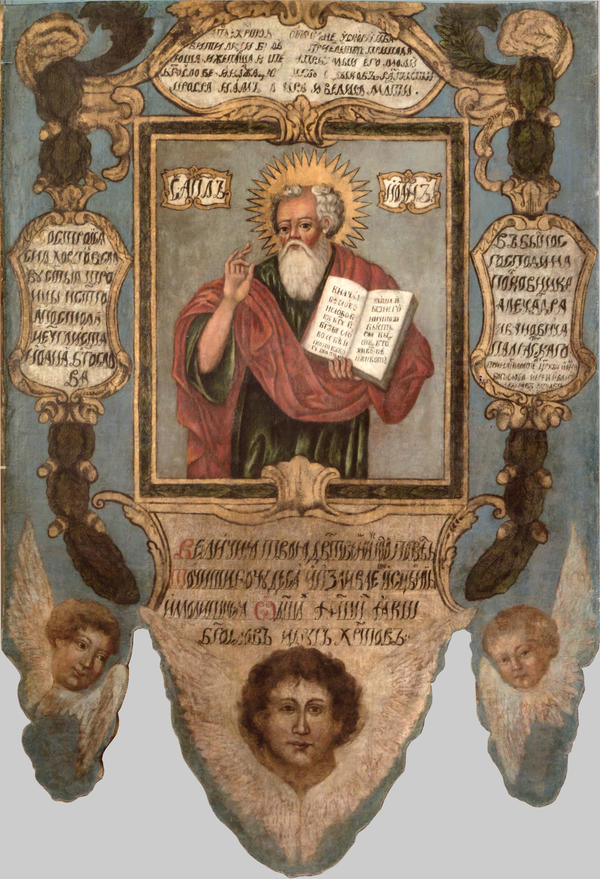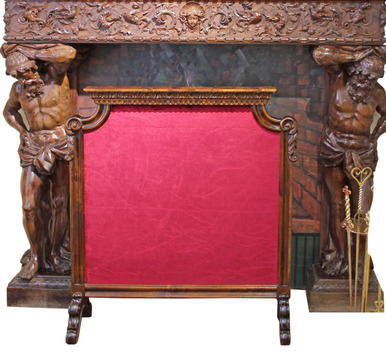The gonofan with the image of John the Theologian and Archangel Michael became one of the relics of the Saransk militia troops participating in the war with Napoleon. This church banner accompanied the militiamen all the way to Paris during the Russian army foreign campaign. After military actions completion, the relic was returned to the Makarovka Church of St. John the Theologian where it was initially kept.
On one side of the gonofan, the author painted in oil Apostle John the Theologian, on the other — Archangel Michael. John the Theologian is represented as an old man holding a book, as he is the author of one of the four canonical texts of the Gospel, the book of Revelation, and three Epistles included in the New Testament.
Archangel Michael was called ‘Archistratigus’, that is, captain of the host of the Lord’, and he is depicted as a winged youth in armor holding a fire sword.
The gonofan examination took a lot of time. It was difficult to examine the religious banner because of its condition. However, it was possible to read the name of the author in the inscription placed on the right. It reads: “in the time of Mr. Colonel Alexander Ivanovich Polyansky belonging (one word is lost) to the Church of John the Theologian, [arch]iereus Ivan Fedorov worked (?).”
The establishment of authorship was a discovery, because iconographers, as a rule, never signed their works. Study of archives revealed that Ivan Fedorov was a priest of the Church of John the Theologian from 1760 to 1769.
The discovered inscription helped to find out that the cloth was made by him in the village of Makarovka.
Study of the biography of landlord Alexander Ivanovich Polyansky who is also mentioned in one of the inscriptions played an important role in specification of the time of the gonofan creation. He rose through the ranks to Colonel in 1754, and in February 1765, he retired from the military service and became a Councillor of State. In the inscription, he is still referred to as a Colonel, consequently, the artefact was created between 1764 and 1765. During military actions, the Polyanskys landlords provided 68 people from the number of their serfs to join the Saransk militia forces. 40 of those people were members of the Makarovka Church.
There is a suggestion that it was at the insistence of landlord Polyansky that, in the military campaign, the militia took the gonofan, which may have been the only religious banner in all of the Saransk militia. This circumstance can explain the fact that it has practically become an Orthodox symbol of the entire County, not just the village.
The relic got to the Museum together with the things withdrawn from the closed John the Apostle Church of the village of Makarovka in 1923. Its condition was very unsatisfactory, and because of the exposure, it has greatly deteriorated. The gonofan’s restoration began in 2009. The staff members of the Academician I.E. Grabar All-Russia Art Research and Restoration Centre worked on this relic for 4 years.
On one side of the gonofan, the author painted in oil Apostle John the Theologian, on the other — Archangel Michael. John the Theologian is represented as an old man holding a book, as he is the author of one of the four canonical texts of the Gospel, the book of Revelation, and three Epistles included in the New Testament.
Archangel Michael was called ‘Archistratigus’, that is, captain of the host of the Lord’, and he is depicted as a winged youth in armor holding a fire sword.
The gonofan examination took a lot of time. It was difficult to examine the religious banner because of its condition. However, it was possible to read the name of the author in the inscription placed on the right. It reads: “in the time of Mr. Colonel Alexander Ivanovich Polyansky belonging (one word is lost) to the Church of John the Theologian, [arch]iereus Ivan Fedorov worked (?).”
The establishment of authorship was a discovery, because iconographers, as a rule, never signed their works. Study of archives revealed that Ivan Fedorov was a priest of the Church of John the Theologian from 1760 to 1769.
The discovered inscription helped to find out that the cloth was made by him in the village of Makarovka.
Study of the biography of landlord Alexander Ivanovich Polyansky who is also mentioned in one of the inscriptions played an important role in specification of the time of the gonofan creation. He rose through the ranks to Colonel in 1754, and in February 1765, he retired from the military service and became a Councillor of State. In the inscription, he is still referred to as a Colonel, consequently, the artefact was created between 1764 and 1765. During military actions, the Polyanskys landlords provided 68 people from the number of their serfs to join the Saransk militia forces. 40 of those people were members of the Makarovka Church.
There is a suggestion that it was at the insistence of landlord Polyansky that, in the military campaign, the militia took the gonofan, which may have been the only religious banner in all of the Saransk militia. This circumstance can explain the fact that it has practically become an Orthodox symbol of the entire County, not just the village.
The relic got to the Museum together with the things withdrawn from the closed John the Apostle Church of the village of Makarovka in 1923. Its condition was very unsatisfactory, and because of the exposure, it has greatly deteriorated. The gonofan’s restoration began in 2009. The staff members of the Academician I.E. Grabar All-Russia Art Research and Restoration Centre worked on this relic for 4 years.






